Eco-Innovation Diversity in a Circular Economy: Towards Circular Innovation Studies
Abstract
:1. Introduction
- How has CE innovation research evolved since 2010?
- What is its distribution? (core academic outlets; core contributors, geographical dispersion, etc.)
- How are innovation dynamics conceptualised in CE research? How are types of innovation defined and unpacked?
2. Materials and Methods
2.1. Choice of Evidence Synthesis Method
2.2. Coding Scheme
2.3. Defining the Literature Corpus
2.4. Data Collection, Screening and Quality Assurance
2.5. Quality Assurance
2.6. Analysis of the Full Texts
3. Results–Trends of the Pro-CE Innovation Research
3.1. Research Dynamics on the EI-CE Nexus
3.2. Citations and Focus of Key Contributions
3.3. Nature and Scope of the EI/CE Research
3.4. Key Types of Innovation in CE: Main Dynamics of the Pro-CE Innovation Research Programme
3.4.1. Recycling and Recovery–Rewiring Production
3.4.2. Consumption and Use—New Business Models
3.4.3. Papers Not Adhering to Specific CE Strategies
3.4.4. Other CE Strategies
4. Discussion
5. Concluding Remarks
Author Contributions
Funding
Acknowledgments
Conflicts of Interest
Abbreviations
| CE | Circular Economy |
| EI | Eco-innovation |
| WoS | Web of Science |
| N/A | Not Applicable |
References
- Rockström, J.; Steffen, W.; Noone, K.; Persson, Å.; Chapin, F.S.; Lambin, E.F.; Lenton, T.M.; Scheffer, M.; Folke, C.; Schellnhuber, H.J.; et al. A Safe Operating Space for Humanity. Nature 2009, 461, 472–475. [Google Scholar] [CrossRef]
- Woetzel, J.; Sellschop, R.; Chui, M.; Ramaswamy, S.; Nyquist, S.; Robinson, H.; Roelofsen, O.; Rogers, M.; Ross, R. How Technology Is Reshaping Supply and Demand for Natural Resources; McKinsey & Company, 2017. [Google Scholar]
- de Angelis, R. Circular Economy: Laying the Foundations for Conceptual and Theoretical Development in Management Studies. Manag. Decis. 2021, 59, 1209–1227. [Google Scholar] [CrossRef]
- Geissdoerfer, M.; Savaget, P.; Bocken, N.M.P.; Hultink, E.J. The Circular Economy—A New Sustainability Paradigm? J. Clean. Prod. 2017, 143, 757–768. [Google Scholar] [CrossRef] [Green Version]
- Korhonen, J.; Honkasalo, A.; Seppälä, J. Circular Economy: The Concept and Its Limitations. Ecol. Econ. 2018, 143, 37–46. [Google Scholar] [CrossRef]
- Ellen MacArthur Foundation. Foundation Delivering the Circular Economy. A Toolkit for Policy Makers; Ellen MacArthur Foundation: Cowes, United Kingdom, 2015. [Google Scholar]
- Centobelli, P.; Cerchione, R.; Chiaroni, D.; Vecchio, P.D.; Urbinati, A. Designing Business Models in Circular Economy: A Systematic Literature Review and Research Agenda. Bus. Strategy Environ. 2020, 29, 1734–1749. [Google Scholar] [CrossRef]
- Denise, R.; Vermeulen, W.; Witjes, S. The circular economy: New or Refurbished as CE 3.0? — Exploring Controversies in the Conceptualization of the Circular Economy through a Focus on History and Resource Value Retention Options. Resour. Conserv. Recycl. 2018, 135, 246–264. [Google Scholar]
- Kirchherr, J.; Reike, D.; Hekkert, M. Conceptualizing the Circular Economy: An Analysis of 114 Definitions. Resour. Conserv. Recycl. 2017, 127, 221–232. [Google Scholar] [CrossRef]
- Sauvé, S.; Bernard, S.; Sloan, P. Environmental Sciences, Sustainable Development and Circular Economy: Alternative Concepts for Trans-Disciplinary Research. Environ. Dev. 2016, 17, 48–56. [Google Scholar] [CrossRef] [Green Version]
- de Jesus, A.; Antunes, P.; Santos, R.; Mendonça, S. Eco-Innovation in the Transition to a Circular Economy: An Analytical Literature Review. J. Clean. Prod. 2018, 172, 2999–3018. [Google Scholar] [CrossRef]
- Kočí, J.; Fořt, J.; Černý, R. Energy Efficiency of Latent Heat Storage Systems in Residential Buildings: Coupled Effects of Wall Assembly and Climatic Conditions. Renewable and Sustainable Energy Rev. 2020, 132, 110097. [Google Scholar] [CrossRef]
- Hamam, M.; Chinnici, G.; Di Vita, G.; Pappalardo, G.; Pecorino, B.; Maesano, G.; D’Amico, M. Circular Economy Models in Agro-Food Systems: A Review. Sustainability 2021, 13, 3453. [Google Scholar] [CrossRef]
- Piribauer, B.; Bartl, A. Textile Recycling Processes, State of the Art and Current Developments: A Mini Review. Waste Manag. Res. 2019, 37, 112–119. [Google Scholar] [CrossRef] [PubMed]
- Calleja, D. Why the “New Plastics Economy” Must Be a Circular Economy. Field Actions Sci. Rep. 2019, 2019, 22–27. [Google Scholar]
- Gong, Y.; Putnam, E.; You, W.; Zhao, C. Investigation into Circular Economy of Plastics: The Case of the UK Fast Moving Consumer Goods Industry. J. Clean. Prod. 2020, 244, 118941. [Google Scholar] [CrossRef]
- Mishra, S.; Jain, S.; Malhotra, G. The Anatomy of Circular Economy Transition in the Fashion Industry. Soc. Responsib. J. 2021, 17, 524–542. [Google Scholar] [CrossRef]
- Shirvanimoghaddam, K.; Motamed, B.; Ramakrishna, S.; Naebe, M. Death by Waste: Fashion and Textile Circular Economy Case. Sci. Total. Environ. 2020, 718, 137317. [Google Scholar] [CrossRef]
- Althaf, S.; Babbitt, C.W.; Chen, R. The Evolution of Consumer Electronic Waste in the United States. J. Ind. Ecol. 2021, 25, 693–706. [Google Scholar] [CrossRef]
- Althaf, S.; Babbitt, C.W.; Chen, R. Forecasting Electronic Waste Flows for Effective Circular Economy Planning. Resour. Conserv. Recycl. 2019, 151, 104362. [Google Scholar] [CrossRef]
- Álvarez-de-los-Mozos, E.; Rentería-Bilbao, A.; Díaz-Martín, F. WEEE Recycling and Circular Economy Assisted by Collaborative Robots. Appl. Sci. 2020, 10, 4800. [Google Scholar] [CrossRef]
- Aschemann-Witzel, J.; Peschel, A.O. How Circular Will You Eat? The Sustainability Challenge in Food and Consumer Reaction to Either Waste-to-Value or yet Underused Novel Ingredients in Food. Food Qual. Prefer. 2019, 77, 15–20. [Google Scholar] [CrossRef]
- Fernandez-Mena, H.; MacDonald, G.K.; Pellerin, S.; Nesme, T. Co-Benefits and Trade-Offs from Agro-Food System Redesign for Circularity: A Case Study with the FAN Agent-Based Model. Front. Sustain. Food Syst. 2020, 4, 41. [Google Scholar] [CrossRef]
- Calabrese, A.; Castaldi, C.; Forte, G.; Levialdi, N.G. Sustainability-Oriented Service Innovation: An Emerging Research Field. J. Clean. Prod. 2018, 193, 533–548. [Google Scholar] [CrossRef]
- Fernandes, S.D.C.; Pigosso, D.C.A.; McAloone, T.C.; Rozenfeld, H. Towards Product-Service System Oriented to Circular Economy: A Systematic Review of Value Proposition Design Approaches. J. Clean. Prod. 2020, 257, 120507. [Google Scholar] [CrossRef]
- Skene, K.R. Circles, Spirals, Pyramids and Cubes: Why the Circular Economy Cannot Work. Sustain. Sci. 2017, 13, 1–14. [Google Scholar] [CrossRef]
- Kalmykova, Y.; Sadagopan, M.; Rosado, L. Circular Economy—From Review of Theories and Practices to Development of Implementation Tools. Resour. Conserv. Recycl. 2018, 135, 190–201. [Google Scholar] [CrossRef]
- Circle Economy. The Circularity Gap Report 2021; Platform for Accelerating the Circular Economy (PACE): Amsterdam, The Netherlands, 2021. [Google Scholar]
- Elzen, B.; Geels, F.W.; Green, K. System Innovation and the Transition to Sustainability: Theory, Evidence and Policy; Edward Elgar Publishing: Cheltenham, UK; Northampton, MA, USA, 2004; ISBN 9781845423421. [Google Scholar]
- Geels, F.W.; Hekkert, M.P.; Jacobsson, S. The Dynamics of Sustainable Innovation Journeys. Technol. Anal. Strateg. Manag. 2008, 20, 521–536. [Google Scholar] [CrossRef] [Green Version]
- European Commission. Communication from the commission to the european parliament, the council, the european economic and social committee and the committee of the regions - Closing the Loop—An EU Action Plan for the Circular Economy; COM(2015) 614 final; European Commission: Brussels, Belgium, 2015. [Google Scholar]
- de Jesus, A.; Antunes, P.; Santos, R.; Mendonça, S. Eco-Innovation Pathways to a Circular Economy: Envisioning Priorities through a Delphi Approach. J. Clean. Prod. 2019, 228, 1494–1513. [Google Scholar] [CrossRef]
- de Jesus, A.; Mendonça, S. Lost in Transition? Drivers and Barriers in the Eco-Innovation Road to the Circular Economy. Ecol. Econ. 2018, 145, 75–89. [Google Scholar] [CrossRef] [Green Version]
- Carrión-Flores, C.E.; Innes, R. Environmental Innovation and Environmental Performance. J. Environ. Econ. Manag. 2010, 59, 27–42. [Google Scholar] [CrossRef]
- van den Bergh, J.C.J.M.; Truffer, B.; Kallis, G. Environmental Innovation and Societal Transitions: Introduction and Overview. Environ. Innov. Soc. Transit. 2011, 1, 1–23. [Google Scholar] [CrossRef]
- Weber, K.M.; Hemmelskamp, J. Towards Environmental Innovation Systems; Springer Science & Business Media: Berlin/Heidelberg, Germany, 2005; ISBN 9783540223221. [Google Scholar]
- Boons, F.; Montalvo, C.; Quist, J.; Wagner, M. Sustainable Innovation, Business Models and Economic Performance: An Overview. J. Clean. Prod. 2013, 45, 1–8. [Google Scholar] [CrossRef]
- Chen, Y.-S.; Lai, S.-B.; Wen, C.-T. The Influence of Green Innovation Performance on Corporate Advantage in Taiwan. J. Bus. Ethics 2006, 67, 331–339. [Google Scholar] [CrossRef]
- Cuerva, M.C.; Triguero-Cano, Á.; Córcoles, D. Drivers of Green and Non-Green Innovation: Empirical Evidence in Low-Tech SMEs. J. Clean. Prod. 2014, 68, 104–113. [Google Scholar] [CrossRef]
- Li, L.; Msaad, H.; Sun, H.; Tan, M.X.; Lu, Y.; Lau, A.K.W. Green Innovation and Business Sustainability: New Evidence from Energy Intensive Industry in China. Int. J. Environ. Res. Public Health 2020, 17, 1–18. [Google Scholar] [CrossRef] [PubMed]
- Horbach, J. Determinants of Environmental Innovation—New Evidence from German Panel Data Sources. Res. Policy 2008, 37, 163–173. [Google Scholar] [CrossRef] [Green Version]
- Carrillo-Hermosilla, J.; del Río, P.; Könnölä, T. Diversity of Eco-Innovations: Reflections from Selected Case Studies. J. Clean. Prod. 2010, 18, 1073–1083. [Google Scholar] [CrossRef]
- Hofstra, N.; Huisingh, D. Eco-Innovations Characterized: A Taxonomic Classification of Relationships between Humans and Nature. J. Clean. Prod. 2014, 66, 459–468. [Google Scholar] [CrossRef]
- Jo, J.-H.; Roh, T.W.; Kim, S.; Youn, Y.-C.; Park, M.S.; Han, K.J.; Jang, E.K. Eco-Innovation for Sustainability: Evidence from 49 Countries in Asia and Europe. Sustainability 2015, 7, 16820–16835. [Google Scholar] [CrossRef] [Green Version]
- Martin, B.R. Twenty Challenges for Innovation Studies. Sci. Public Policy 2016, 43, 432–450. [Google Scholar] [CrossRef] [Green Version]
- Schot, J.; Kanger, L. Deep Transitions: Emergence, Acceleration, Stabilization and Directionality. Res. Policy 2018, 47, 1045–1059. [Google Scholar] [CrossRef]
- Konietzko, J.; Bocken, N.; Hultink, E.J. Circular Ecosystem Innovation: An Initial Set of Principles. J. Clean. Prod. 2020, 253, 119942. [Google Scholar] [CrossRef]
- Brewerton, P.M.; Millward, L. Organizational Research Methods: A Guide for Students and Researchers, 1st ed.; SAGE Publications: London, UK; Thousand Oaks, CA, USA, 2001; ISBN 9780761971016. [Google Scholar]
- Denyer, D.; Tranfield, D. Producing a systematic review. In The Sage Handbook of Organizational Research Methods; Sage Publications Ltd: Thousand Oaks, CA, USA, 2009; pp. 671–689. ISBN 9781412931182. [Google Scholar]
- Tranfield, D.; Denyer, D.; Smart, P. Towards a Methodology for Developing Evidence-Informed Management Knowledge by Means of Systematic Review. Br. J. Manag. 2003, 14, 207–222. [Google Scholar] [CrossRef]
- Merli, R.; Preziosi, M.; Acampora, A. How Do Scholars Approach the Circular Economy? A Systematic Literature Review. J. Clean. Prod. 2018, 178, 703–722. [Google Scholar] [CrossRef]
- Xavier, A.F.; Naveiro, R.M.; Aoussat, A.; Reyes, T. Systematic Literature Review of Eco-Innovation Models: Opportunities and Recommendations for Future Research. J. Clean. Prod. 2017, 149, 1278–1302. [Google Scholar] [CrossRef]
- Akhimien, N.G.; Latif, E.; Hou, S.S. Application of Circular Economy Principles in Buildings: A Systematic Review. J. Build. Eng. 2021, 38, 102041. [Google Scholar] [CrossRef]
- Bocken, N.; Strupeit, L.; Whalen, K.; Nußholz, J. A Review and Evaluation of Circular Business Model Innovation Tools. Sustainability 2019, 11, 2210. [Google Scholar] [CrossRef] [Green Version]
- de Oliveira, M.M.; Lago, A.; Dal’Magro, G.P. Food Loss and Waste in the Context of the Circular Economy: A Systematic Review. J. Clean. Prod. 2021, 294, 126284. [Google Scholar] [CrossRef]
- Rosa, P.; Sassanelli, C.; Urbinati, A.; Chiaroni, D.; Terzi, S. Assessing Relations between Circular Economy and Industry 4.0: A Systematic Literature Review. Int. J. Prod. Res. 2020, 58, 1662–1687. [Google Scholar] [CrossRef] [Green Version]
- Padilla-Rivera, A.; Russo-Garrido, S.; Merveille, N. Addressing the Social Aspects of a Circular Economy: A Systematic Literature Review. Sustainability 2020, 12, 7912. [Google Scholar] [CrossRef]
- de Pascale, A.; Arbolino, R.; Szopik-Depczyńska, K.; Limosani, M.; Ioppolo, G. A Systematic Review for Measuring Circular Economy: The 61 Indicators. J. Clean. Prod. 2021, 281, 124942. [Google Scholar] [CrossRef]
- Martinho, V.J.P.D. Insights into Circular Economy Indicators: Emphasizing Dimensions of Sustainability. Environ. Sustain. Indic. 2021, 10, 100119. [Google Scholar] [CrossRef]
- Sassanelli, C.; Rosa, P.; Rocca, R.; Terzi, S. Circular Economy Performance Assessment Methods: A Systematic Literature Review. J. Clean. Prod. 2019, 229, 440–453. [Google Scholar] [CrossRef]
- Edwards-Schachter, M. The Nature and Variety of Innovation. Int. J. Innov. Stud. 2018, 2, 65–79. [Google Scholar] [CrossRef]
- Organisation for Economic Co-operation and Development. The Measurement of Scientific and Technological Activities—Oslo Manual; Guidelines for Collecting and Interpreting Innovation Data, 3rd. ed; OECD Publishing: Paris, France, 2005; ISBN 9789264013100. [Google Scholar]
- Colvin, J.; Blackmore, C.; Chimbuya, S.; Collins, K.; Dent, M.; Goss, J.; Ison, R.; Roggero, P.P.; Seddaiu, G. In Search of Systemic Innovation for Sustainable Development: A Design Praxis Emerging from a Decade of Social Learning Inquiry. Res. Policy 2014, 43, 760–771. [Google Scholar] [CrossRef]
- Gaziulusoy, A.İ.; Boyle, C.; McDowall, R. System Innovation for Sustainability: A Systemic Double-Flow Scenario Method for Companies. J. Clean. Prod. 2013, 45, 104–116. [Google Scholar] [CrossRef]
- Boons, F.; Lüdeke-Freund, F. Business Models for Sustainable Innovation: State-of-the-Art and Steps towards a Research Agenda. J. Clean. Prod. 2013, 45, 9–19. [Google Scholar] [CrossRef]
- Geissdoerfer, M.; Vladimirova, D.; Evans, S. Sustainable Business Model Innovation: A Review. J. Clean. Prod. 2018, 198, 401–416. [Google Scholar] [CrossRef]
- OECD. Oslo Manual 2018: Guidelines for Collecting, Reporting and Using Data on Innovation, 4th ed.; OECD: Paris, France, 2018. [Google Scholar]
- Zhu, J.; Liu, W. A Tale of Two Databases: The Use of Web of Science and Scopus in Academic Papers. Scientometrics 2020, 123, 321–335. [Google Scholar] [CrossRef] [Green Version]
- Falagas, M.E.; Pitsouni, E.I.; Malietzis, G.A.; Pappas, G. Comparison of PubMed, Scopus, Web of Science, and Google Scholar: Strengths and Weaknesses. FASEB J. 2008, 22, 338–342. [Google Scholar] [CrossRef] [PubMed]
- Chappin, E.J.L.; Ligtvoet, A. Transition and Transformation: A Bibliometric Analysis of Two Scientific Networks Researching Socio-Technical Change. Renew. Sustain. Energy Rev. 2014, 30, 715–723. [Google Scholar] [CrossRef] [Green Version]
- Chadegani, A.A.; Salehi, H.; Yunus, M.; Farhadi, H.; Fooladi, M.; Farhadi, M.; Ebrahim, A.E. Comparison between Two Main Academic Literature Collections: Web of Science and Scopus Databases; Social Science Research Network: Rochester, NY, USA, 2013. [Google Scholar]
- Haddaway, N.R.; Grames, E.M.; Boyes, D.H.; Saunders, M.E.; Taylor, N.G. What Evidence Exists on Conservation Actions to Conserve Insects? A Protocol for a Systematic Map of Literature Reviews. Environ. Evid. 2020, 9, 30. [Google Scholar] [CrossRef]
- Smith, V.; Devane, D.; Begley, C.M.; Clarke, M. Methodology in Conducting a Systematic Review of Systematic Reviews of Healthcare Interventions. BMC Med Res. Methodol. 2011, 11, 15. [Google Scholar] [CrossRef] [Green Version]
- Becker, L.; Oxman, A. Cochrane Handbook for Systematic Reviews of Interventions; Higgins, J.P., Green, S., Eds.; The Cochrane Collaboration: Oxford, UK, 2009. [Google Scholar]
- Camón Luis, E.; Celma, D. Circular Economy. A Review and Bibliometric Analysis. Sustainability 2020, 12, 6381. [Google Scholar] [CrossRef]
- Palmatier, R.W.; Houston, M.B.; Hulland, J. Review Articles: Purpose, Process, and Structure. J. Acad. Mark. Sci. 2018, 46, 1–5. [Google Scholar] [CrossRef] [Green Version]
- Van Dinter, R.; Tekinerdogan, B.; Catal, C. Automation of systematic literature reviews: A systematic literature review. Inf. Sotfw. Technol. 2021, 136, 106589. [Google Scholar] [CrossRef]
- Buchheim, L.; Krieger, A.; Arndt, S. Innovation Types in Public Sector Organizations: A Systematic Review of the Literature. Manag. Rev. Q. 2020, 70, 509–533. [Google Scholar] [CrossRef]
- Bown, M.J.; Sutton, A.J. Quality Control in Systematic Reviews and Meta-Analyses. Eur. J. Vasc. Endovasc. Surg. 2010, 40, 669–677. [Google Scholar] [CrossRef] [Green Version]
- Haddaway, N.R.; Bernes, C.; Jonsson, B.G.; Hedlund, K. The benefits of systematic mapping to evidence-based environmental management. Ambio 45, 613–620 (2016). Ambio 2016, 45, 613–620. [Google Scholar] [CrossRef] [Green Version]
- James, K.L.; Randall, N.P.; Haddaway, N.R. A Methodology for Systematic Mapping in Environmental Sciences. Environ. Evid. 2016, 5, 7. [Google Scholar] [CrossRef] [Green Version]
- Prieto-Sandoval, V.; Jaca, C.; Ormazabal, M. Towards a Consensus on the Circular Economy. J. Clean. Prod. 2018, 179, 605–615. [Google Scholar] [CrossRef]
- Nascimento, D.L.M.; Alencastro, V.; Quelhas, O.L.G.; Caiado, R.G.G.; Garza-Reyes, J.A.; Lona, L.R.; Tortorella, G. Exploring Industry 4.0 Technologies to Enable Circular Economy Practices in a Manufacturing Context: A Business Model Proposal. J. Manuf. Technol. Manag. 2019, 30, 607–627. [Google Scholar] [CrossRef]
- Rizos, V.; Behrens, A.; Van der Gaast, W.; Hofman, E.; Ioannou, A.; Kafyeke, T.; Flamos, A.; Rinaldi, R.; Papadelis, S.; Hirschnitz-Garbers, M.; et al. Implementation of Circular Economy Business Models by Small and Medium-Sized Enterprises (SMEs): Barriers and Enablers. Sustainability 2016, 8, 1212. [Google Scholar] [CrossRef] [Green Version]
- Tijssen, R.J.W.; Visser, M.S.; van Leeuwen, T.N. Benchmarking International Scientific Excellence: Are Highly Cited Research Papers an Appropriate Frame of Reference? Scientometrics 2002, 54, 381–397. [Google Scholar] [CrossRef]
- Shapira, Z. “I’ve Got a Theory Paper—Do You?”: Conceptual, Empirical, and Theoretical Contributions to Knowledge in the Organizational Sciences. Organ. Sci. 2011, 22, 1312–1321. [Google Scholar] [CrossRef]
- Amato, A.; Becci, A.; Beolchini, F. Citric Acid Bioproduction: The Technological Innovation Change. Crit. Rev. Biotechnol. 2020, 40, 199–212. [Google Scholar] [CrossRef]
- Carillo, P.; Amelia, L.D.; Aversana, E.D.; Faiella, D.; Cacace, D.; Giuliano, B.; Morrone, B. Eco-Friendly Use of Tomato Processing Residues for Lactic Acid Production in Campania. Chem. Eng. Trans. 2018, 64, 223–228. [Google Scholar] [CrossRef]
- Maschmeyer, T.; Luque, R.; Selva, M. Upgrading of Marine (Fish and Crustaceans) Biowaste for High Added-Value Molecules and Bio(Nano)-Materials. Chem. Soc. Rev. 2020, 49, 4527–4563. [Google Scholar] [CrossRef] [PubMed]
- Dewick, P.; Maytorena-Sanchez, E.; Winch, G. Regulation and Regenerative Eco-Innovation: The Case of Extracted Materials in the UK. Ecol. Econ. 2019, 160, 38–51. [Google Scholar] [CrossRef]
- Hopkinson, P.; Chen, H.-M.; Zhou, K.; Wang, Y.; Lam, D. Recovery and Reuse of Structural Products from End-of-Life Buildings. Proc. Inst. Civ. Eng.—Eng. Sustain. 2019, 172, 119–128. [Google Scholar] [CrossRef] [Green Version]
- Rocchetti, L.; Amato, A.; Beolchini, F. Printed Circuit Board Recycling: A Patent Review. J. Clean. Prod. 2018, 178, 814–832. [Google Scholar] [CrossRef]
- Sarc, R.; Curtis, A.; Kandlbauer, L.; Khodier, K.; Lorber, K.E.; Pomberger, R. Digitalisation and Intelligent Robotics in Value Chain of Circular Economy Oriented Waste Management—A Review. Waste Manag. 2019, 95, 476–492. [Google Scholar] [CrossRef]
- Ubaldini, S.; Guglietta, D.; Trapasso, F.; Carloni, S.; Passeri, D.; Scotti, A. Treatment of Secondary Raw Materials by Innovative Processes. Chem. J. Mold. 2019, 14, 32–46. [Google Scholar] [CrossRef]
- Akyol, Ç.; Foglia, A.; Ozbayram, E.G.; Frison, N.; Katsou, E.; Eusebi, A.L.; Fatone, F. Validated Innovative Approaches for Energy-Efficient Resource Recovery and Re-Use from Municipal Wastewater: From Anaerobic Treatment Systems to a Biorefinery Concept. Crit. Rev. Environ. Sci. Technol. 2020, 50, 869–902. [Google Scholar] [CrossRef]
- Blankesteijn, M.; Bossink, B. Assessing the Legitimacy of Technological Innovation in the Public Sphere: Recovering Raw Materials from Waste Water. Sustainability 2020, 12, 9408. [Google Scholar] [CrossRef]
- Dąbrowski, M.; Varjú, V.; Amenta, L. Transferring Circular Economy Solutions across Differentiated Territories: Understanding and Overcoming the Barriers for Knowledge Transfer. Urban Plan. 2019, 4, 52–62. [Google Scholar] [CrossRef]
- Robles, Á.; Aguado, D.; Barat, R.; Borrás, L.; Bouzas, A.; Giménez, J.B.; Martí, N.; Ribes, J.; Ruano, M.V.; Serralta, J.; et al. New Frontiers from Removal to Recycling of Nitrogen and Phosphorus from Wastewater in the Circular Economy. Bioresour. Technol. 2020, 300, 122673. [Google Scholar] [CrossRef] [PubMed]
- Branca, T.A.; Colla, V.; Algermissen, D.; Granbom, H.; Martini, U.; Morillon, A.; Pietruck, R.; Rosendahl, S. Reuse and Recycling of By-Products in the Steel Sector: Recent Achievements Paving the Way to Circular Economy and Industrial Symbiosis in Europe. Metals 2020, 10, 345. [Google Scholar] [CrossRef] [Green Version]
- Patricio, J.; Axelsson, L.; Blomé, S.; Rosado, L. Enabling Industrial Symbiosis Collaborations between SMEs from a Regional Perspective. J. Clean. Prod. 2018, 202, 1120–1130. [Google Scholar] [CrossRef]
- Naims, H. Economic Aspirations Connected to Innovations in Carbon Capture and Utilization Value Chains. J. Ind. Ecol. 2020, 24, 1126–1139. [Google Scholar] [CrossRef] [Green Version]
- Azcárate-Aguerre, J.F.; Den Heijer, A.; Klein, T. Integrated Faades as a Product-Service System -Business Process Innovation to Accelerate Integral Product Implementation. J. Facade Des. Eng. 2018, 6, 41–56. [Google Scholar] [CrossRef]
- Guzzo, D.; Trevisan, A.H.; Echeveste, M.; Costa, J.M.H. Circular Innovation Framework: Verifying Conceptual to Practical Decisions in Sustainability-Oriented Product-Service System Cases. Sustainability 2019, 11, 3248. [Google Scholar] [CrossRef] [Green Version]
- Sposato, P.; Preka, R.; Cappellaro, F.; Cutaia, L. Sharing Economy and Circular Economy. How Technology and Collaborative Consumption Innovations Boost Closing the Loop Strategies. Environ. Eng. Manag. J. 2017, 16, 1797–1806. [Google Scholar] [CrossRef]
- Geissdoerfer, M.; Pieroni, M.P.P.; Pigosso, D.C.A.; Soufani, K. Circular Business Models: A Review. J. Clean. Prod. 2020, 277, 123741. [Google Scholar] [CrossRef]
- Müller, M.; Vorraber, W.; Slany, W. Open Principles in New Business Models for Information Systems. J. Open Innov. Technol. Mark. Complex. 2019, 5, 6. [Google Scholar] [CrossRef] [Green Version]
- Nosratabadi, S.; Mosavi, A.; Shamshirband, S.; Zavadskas, E.K.; Rakotonirainy, A.; Chau, K.W. Sustainable Business Models: A Review. Sustainability 2019, 11, 1663. [Google Scholar] [CrossRef] [Green Version]
- Nußholz, J.L.K. Circular Business Models: Defining a Concept and Framing an Emerging Research Field. Sustainability 2017, 9, 1810. [Google Scholar] [CrossRef] [Green Version]
- Todeschini, B.V.; Cortimiglia, M.N.; Callegaro-de-Menezes, D.; Ghezzi, A. Innovative and Sustainable Business Models in the Fashion Industry: Entrepreneurial Drivers, Opportunities, and Challenges. Bus. Horiz. 2017, 60, 759–770. [Google Scholar] [CrossRef]
- Reim, W.; Parida, V.; Sjödin, D.R. Circular Business Models for the Bio-Economy: A Review and New Directions for Future Research. Sustainability 2019, 11, 2558. [Google Scholar] [CrossRef] [Green Version]
- Cristoni, N.; Tonelli, M. Perceptions of Firms Participating in a Circular Economy. Eur. J. Sustain. Dev. 2018, 7, 105. [Google Scholar] [CrossRef] [Green Version]
- Borrello, M.; Pascucci, S.; Caracciolo, F.; Lombardi, A.; Cembalo, L. Consumers Are Willing to Participate in Circular Business Models: A Practice Theory Perspective to Food Provisioning. J. Clean. Prod. 2020, 259, 121013. [Google Scholar] [CrossRef]
- Hankammer, S.; Brenk, S.; Fabry, H.; Nordemann, A.; Piller, F.T. Towards Circular Business Models: Identifying Consumer Needs Based on the Jobs-to-Be-Done Theory. J. Clean. Prod. 2019, 231, 341–358. [Google Scholar] [CrossRef]
- Jakhar, S.K.; Mangla, S.K.; Luthra, S.; Kusi-Sarpong, S. When Stakeholder Pressure Drives the Circular Economy: Measuring the Mediating Role of Innovation Capabilities. Manag. Decis. 2019, 57, 904–920. [Google Scholar] [CrossRef]
- Sattari, S.; Wessman, A.; Borders, L. Business Model Innovation for Sustainability: An Investigation of Consumers’ Willingness to Adopt Product-Service Systems. J. Glob. Sch. Mark. Sci. 2020, 30, 274–290. [Google Scholar] [CrossRef]
- Zalewski, R.I. Circular Economy as a Management Model in the Paradigm of Sustainable Development. Management 2018, 22, 217–233. [Google Scholar] [CrossRef] [Green Version]
- Horbach, J.; Rammer, C. Circular Economy Innovations, Growth and Employment at the Firm Level: Empirical Evidence from Germany. J. Ind. Ecol. 2020, 24, 615–625. [Google Scholar] [CrossRef] [Green Version]
- Smol, M.; Kulczycka, J. Towards Innovations Development in the European Raw Material Sector by Evolution of the Knowledge Triangle. Resour. Policy 2019, 62, 453–462. [Google Scholar] [CrossRef]
- Mead, T.; Jeanrenaud, S.; Bessant, J. Factors Influencing the Application of Nature as Inspiration for Sustainability-Oriented Innovation in Multinational Corporations. Bus. Strategy Environ. 2020, 29, 3162–3173. [Google Scholar] [CrossRef]
- Colombo, L.A.; Pansera, M.; Owen, R. The Discourse of Eco-Innovation in the European Union: An Analysis of the Eco-Innovation Action Plan and Horizon 2020. J. Clean. Prod. 2019, 214, 653–665. [Google Scholar] [CrossRef] [Green Version]
- Konietzko, J.; Bocken, N.; Hultink, E.J. A Tool to Analyze, Ideate and Develop Circular Innovation Ecosystems. Sustainability 2020, 12. [Google Scholar] [CrossRef] [Green Version]
- Barrie, J.; Zawdie, G.; João, E. Leveraging Triple Helix and System Intermediaries to Enhance Effectiveness of Protected Spaces and Strategic Niche Management for Transitioning to Circular Economy. Int. J. Technol. Manag. Sustain. Dev. 2017, 16, 25–47. [Google Scholar] [CrossRef]
- Durán-Romero, G.; López, A.M.; Beliaeva, T.; Ferasso, M.; Garonne, C.; Jones, P. Bridging the Gap between Circular Economy and Climate Change Mitigation Policies through Eco-Innovations and Quintuple Helix Model. Technol. Forecast. Soc. Chang. 2020, 160, 120246. [Google Scholar] [CrossRef]
- Birtchnell, T.; Urry, J. 3D, SF and the Future. Futures 2013, 50, 25–34. [Google Scholar] [CrossRef]
- Bröring, S.; Laibach, N.; Wustmans, M. Innovation Types in the Bioeconomy. J. Clean. Prod. 2020, 266, 121939. [Google Scholar] [CrossRef]
- Hedeler, B.; Lettner, M.; Stern, T.; Schwarzbauer, P.; Hesser, F. Strategic Decisions on Knowledge Development and Diffusion at Pilot and Demonstration Projects: An Empirical Mapping of Actors, Projects and Strategies in the Case of Circular Forest Bioeconomy. For. Policy Econ. 2020, 110, 102027. [Google Scholar] [CrossRef]
- Guillard, V.; Gaucel, S.; Fornaciari, C.; Angellier-Coussy, H.; Buche, P.; Gontard, N. The Next Generation of Sustainable Food Packaging to Preserve Our Environment in a Circular Economy Context. Front. Nutr. 2018, 5, 121. [Google Scholar] [CrossRef] [Green Version]
- Cerimi, K.; Akkaya, K.C.; Pohl, C.; Schmidt, B.; Neubauer, P. Fungi as Source for New Bio-Based Materials: A Patent Review. Fungal Biol. Biotechnol. 2019, 6, 17. [Google Scholar] [CrossRef] [Green Version]
- Baldassarre, B.; Keskin, D.; Diehl, J.C.; Bocken, N.; Calabretta, G. Implementing Sustainable Design Theory in Business Practice: A Call to Action. J. Clean. Prod. 2020, 273, 123113. [Google Scholar] [CrossRef]
- Lesakova, L. Small and Medium Enterprises and Eco-Innovations: Empirical Study of Slovak SME´s. Mark. Manag. Innov. 2019, 3, 89–97. [Google Scholar] [CrossRef]
- Whicher, A.; Harris, C.; Beverley, K.; Swiatek, P. Design for Circular Economy: Developing an Action Plan for Scotland. J. Clean. Prod. 2018, 172, 3237–3248. [Google Scholar] [CrossRef]
- Cottafava, D.; Riccardo, L.E.; D’Affuso, C. From Flow to Stock. New Circular Business Models for Integrated Systems: A Case Study on Reusable Plastic Cups. Procedia Environ. Sci. Eng. Manag. 2019, 6, 81–94. [Google Scholar]
- Kuo, T.-C.; Smith, S. A Systematic Review of Technologies Involving Eco-Innovation for Enterprises Moving towards Sustainability. J. Clean. Prod. 2018, 192, 207–220. [Google Scholar] [CrossRef]
- Tebaldi, L.; Bigliardi, B.; Bottani, E. Sustainable Supply Chain and Innovation: A Review of the Recent Literature. Sustainability 2018, 10, 3946. [Google Scholar] [CrossRef] [Green Version]
- Maldonado-Guzmán, G.; Garza-Reyes, J.A.; Pinzón-Castro, Y. Eco-Innovation and the Circular Economy in the Automotive Industry. Benchmarking Int. J. 2020, 28, 621–635. [Google Scholar] [CrossRef]
- Chauvy, R.; de Weireld, G. CO2 Utilization Technologies in Europe: A Short Review. Energy Technol. 2020, 8, 2000627. [Google Scholar] [CrossRef]
- Vokoun, M.; Jílková, J. Eco-Innovation Activities in the Czech Economy 2008–2014: Impact of the Eco-Innovative Approach to the Profit Stream and Differences in Urban and Rural Enterprises. Economies 2020, 8, 3. [Google Scholar] [CrossRef] [Green Version]
- Bui, T.D.; Ali, M.H.; Tsai, F.M.; Iranmanesh, M.; Tseng, M.-L.; Lim, M.K. Challenges and Trends in Sustainable Corporate Finance: A Bibliometric Systematic Review. J. Risk Financ. Manag. 2020, 13, 264. [Google Scholar] [CrossRef]
- Cioffi, R.; Travaglioni, M.; Piscitelli, G.; Petrillo, A.; Parmentola, A. Smart Manufacturing Systems and Applied Industrial Technologies for a Sustainable Industry: A Systematic Literature Review. Appl. Sci. 2020, 10, 2897. [Google Scholar] [CrossRef] [Green Version]
- Hojnik, J.; Ruzzier, M.; Manolova, T. Eco-Innovation and Firm Efficiency: Empirical Evidence from Slovenia. Foresight STI Gov. 2017, 11, 103–111. [Google Scholar] [CrossRef]
- Kiefer, C.P.; Carrillo-Hermosilla, J.; Del Río, P. Building a Taxonomy of Eco-Innovation Types in Firms. A Quantitative Perspective. Resour. Conserv. Recycl. 2019, 145, 339–348. [Google Scholar] [CrossRef]
- Leitão, J.; Pereira, D.; Brito, S.D. Inbound and Outbound Practices of Open Innovation and Eco-Innovation: Contrasting Bioeconomy and Non-Bioeconomy Firms. J. Open Innov. Technol. Mark. Complex. 2020, 6, 145. [Google Scholar] [CrossRef]
- Santos, A.B.; Bogers, M.; Norm, M.T.; Mendonça, S. Public policy for open innovation: Opening up to a new domain for research and practice. Technol. Forecast. Soc. Chang. 2021, 169, 1–4. [Google Scholar] [CrossRef]

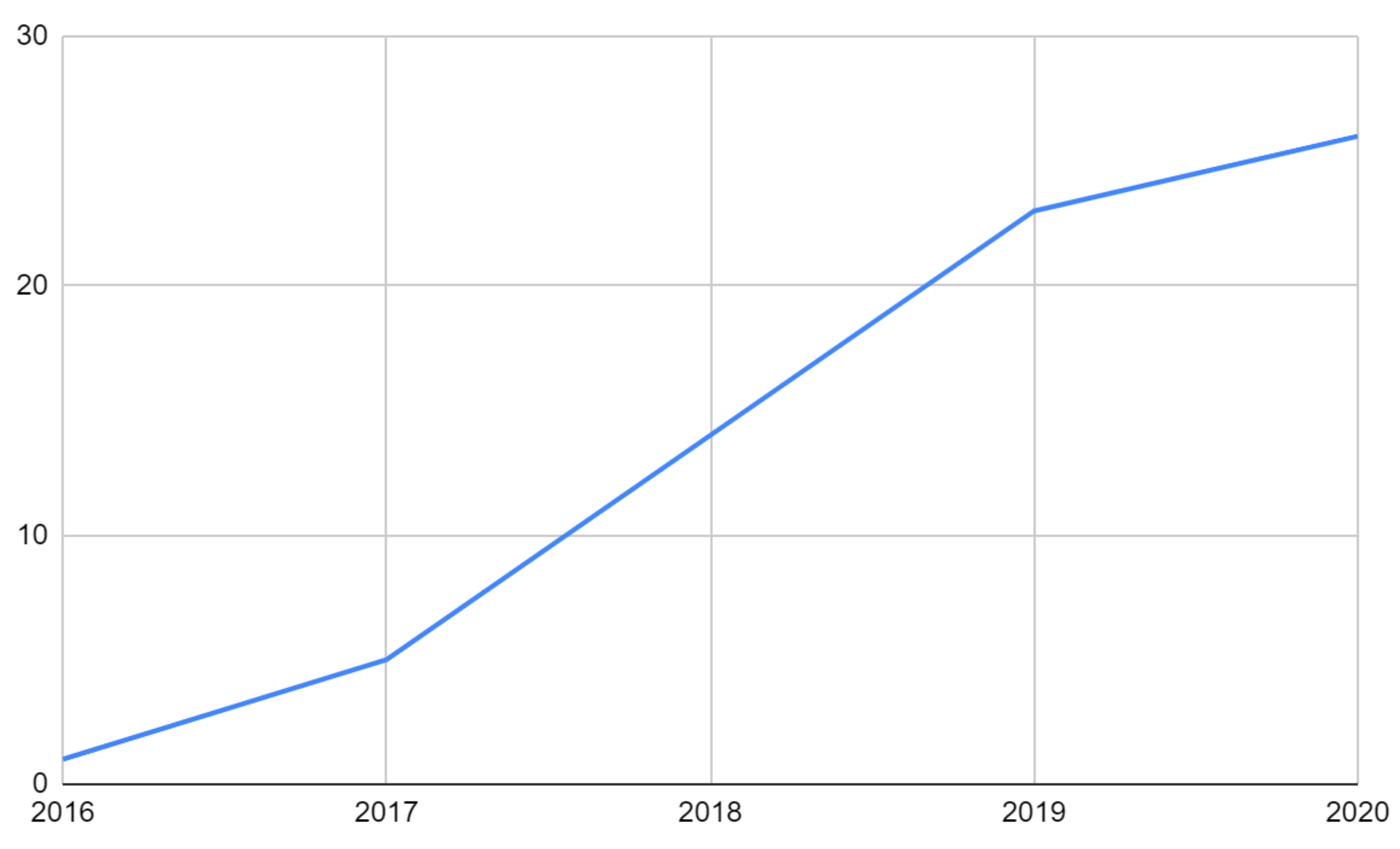
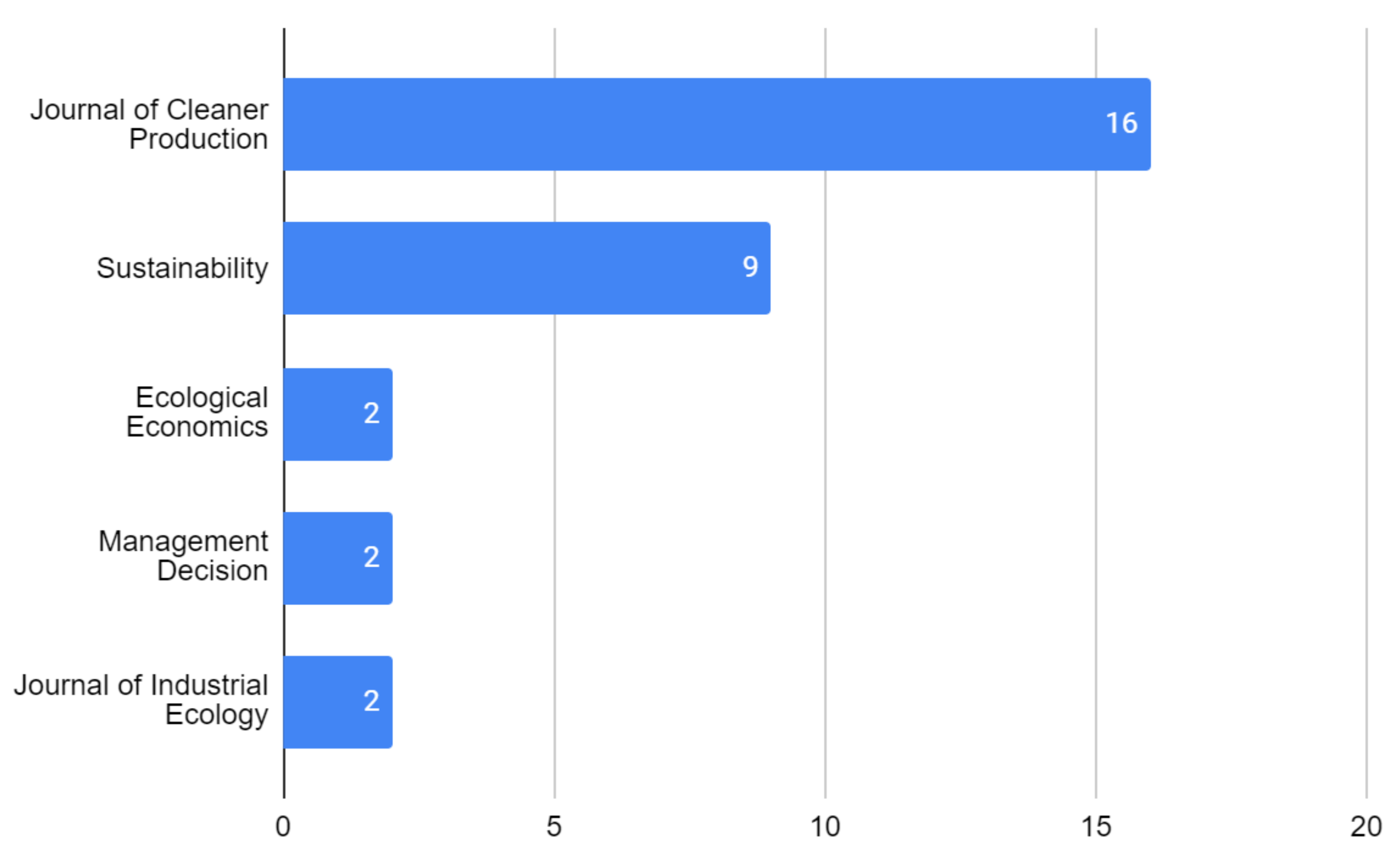
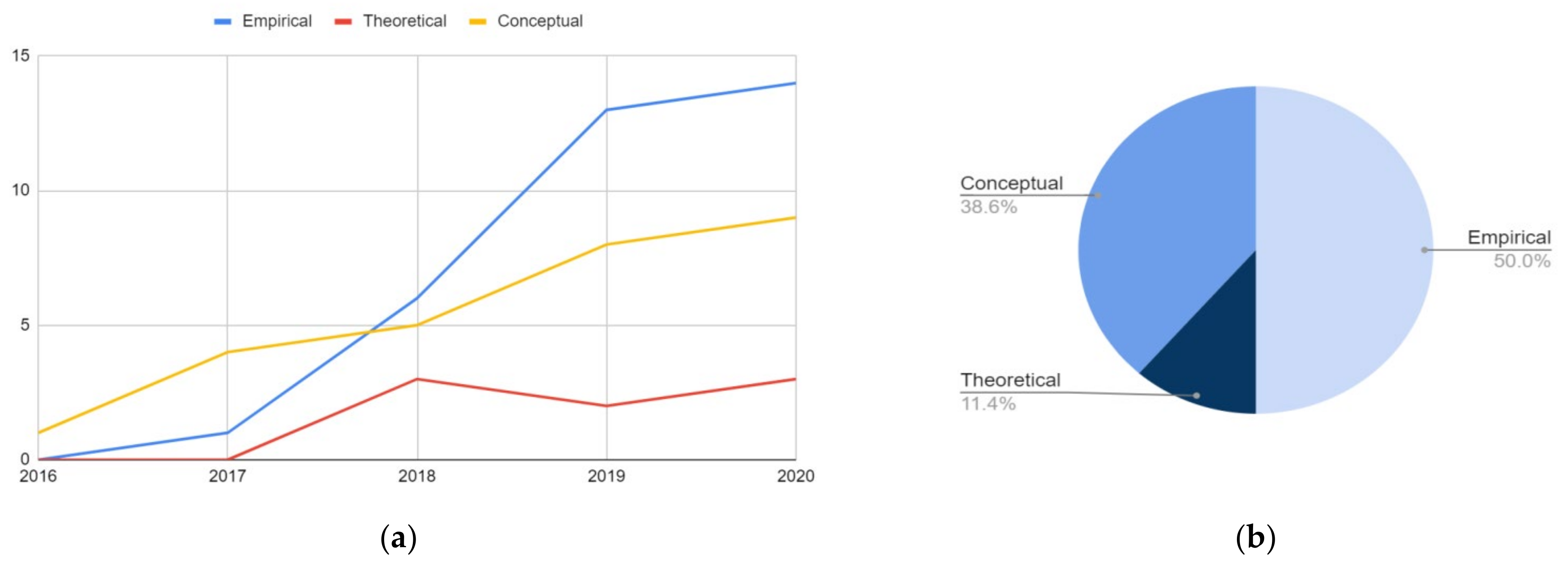
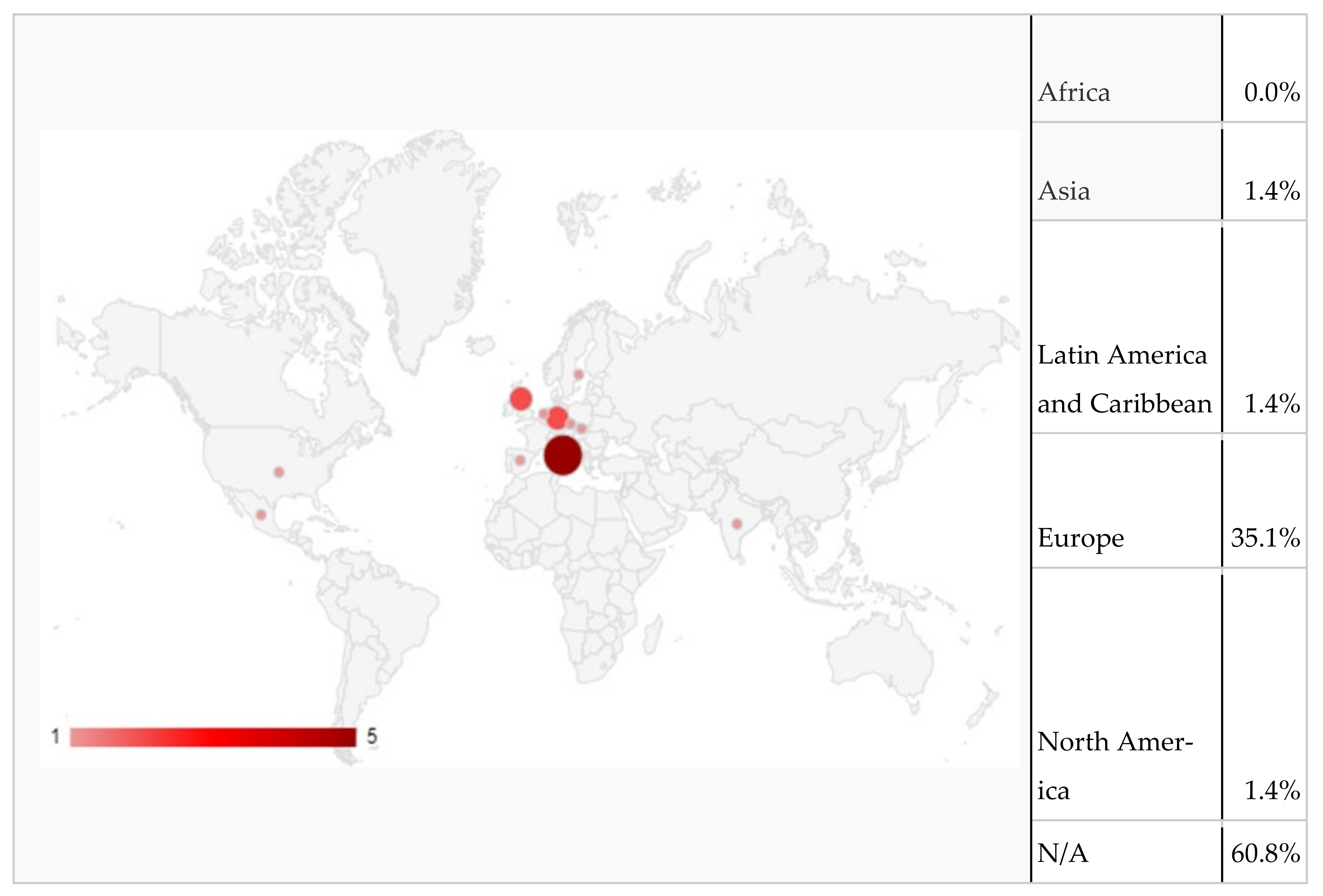

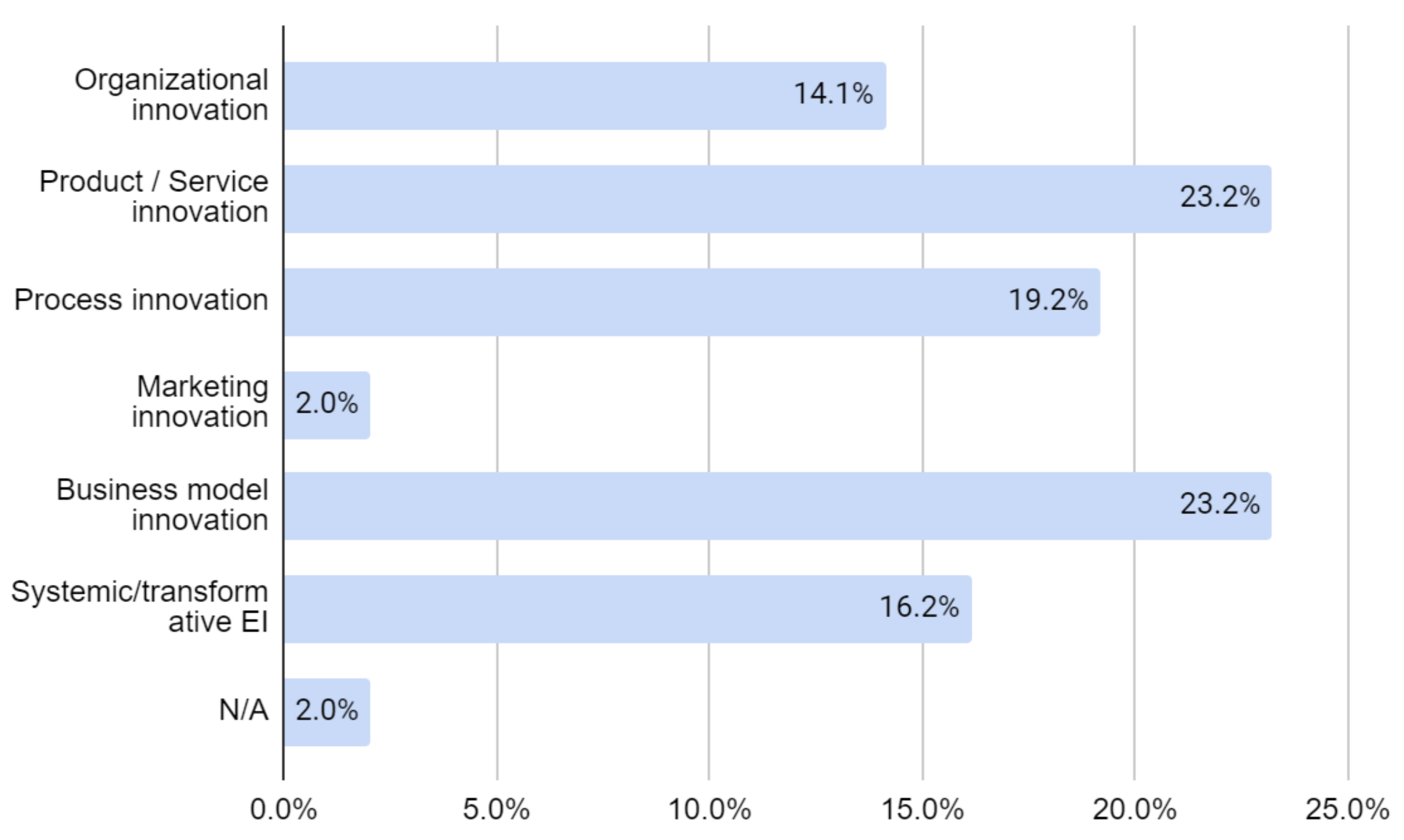

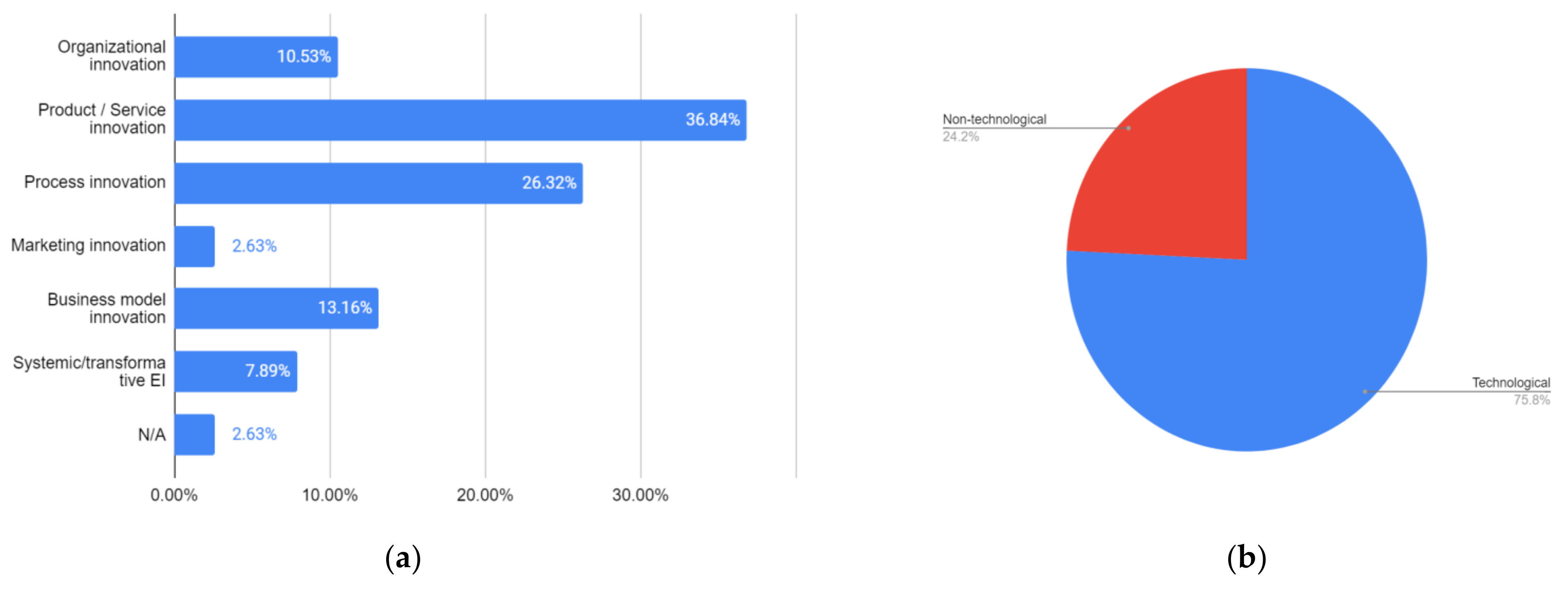
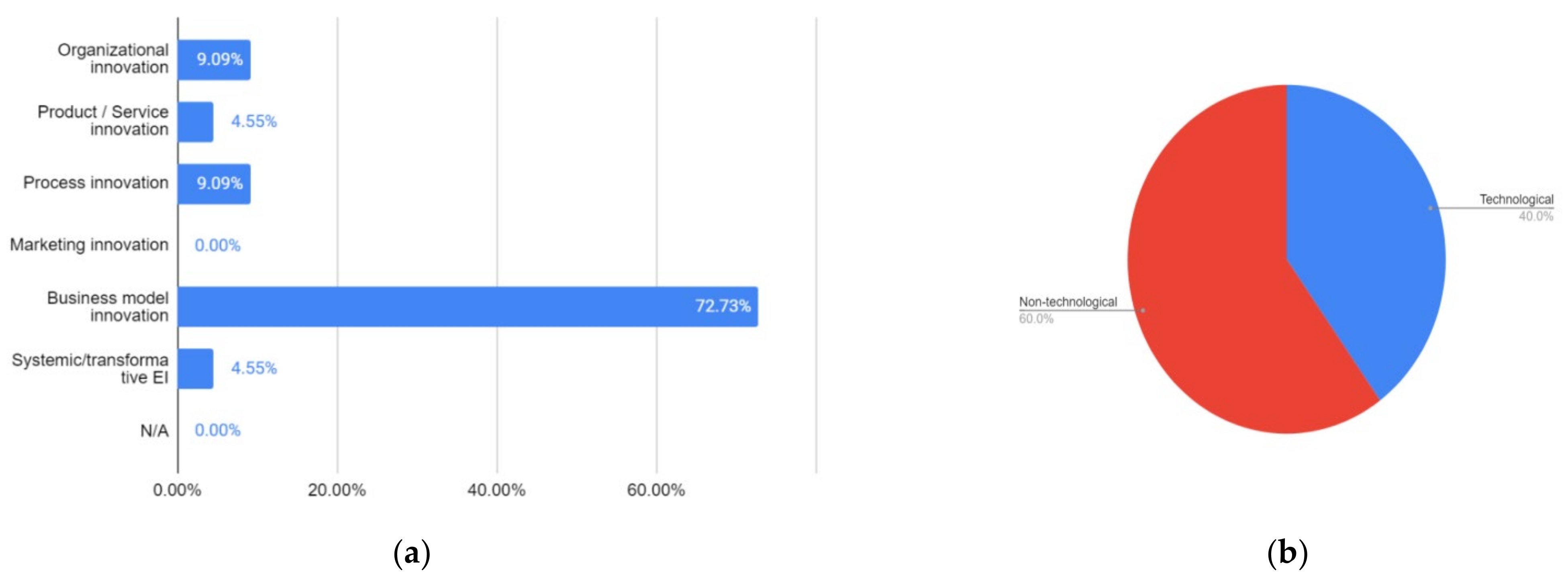

| CE Strategies | ||
|---|---|---|
| Value Chain Stage | Implementation Levels | Definition |
| 1. Materials sourcing |
| CE Strategies focused on materials sourcing renewable energy production as well as energy production from by-products and/or residual wastes; material substitution to renewable options; green procurement; improved standardized method to better quantifies environmental impacts; better taxation system not only of inputs with negative externalities (aggravate) as well as inputs with less environmental externalities (like bio-based materials reducing). |
| 2. Design |
| CE Strategies focused on design to reduce harmful substances use/waste/extended life/disassembly/repair/refurbishment or recycling. Focus is on design to limit environmental impacts during the whole lifecycle. |
| 3. Manufacturing |
| CE Strategies focused on reduced material input/consumption and energy efficient processes. |
| 4. Distribution and sales |
| CE Strategies focused on efficient packaging and extended product life (like resale). |
| 5. Consumption and use |
| CE Strategies focused on environmental certification/labelling; new business models; product-service-systems; sharing and dematerialization models. |
| 6. Collection and disposal |
| CE Strategies focused on take-back systems and extended producer responsibility to a post-consumer stage of a product’s life cycle; as well as recycling, namely enabling facilities to post-consumer optimum separation, collection and disposal. |
| 7. Recycling and recovery |
| CE Strategies focused on using byproducts as raw materials; cascading materials and components (downcycling/upcycling). Element/substance/material recovery; exchange and/or sharing of resources, services and by-products between companies (e.g., industrial symbiosis). |
| 8. Remanufacture |
| CE Strategies focused on maintenance/upgrading and replacing components by reusable substitutes. |
| 9. Circular inputs |
| CE Strategies focused on regenerable inputs. |
| Focus | Key Types of Innovation (Targets) | |
|---|---|---|
| Narrow Focus | Organisational -novel organisational method focused on improving organizational structures in business/workplace organisation, learning processes, institutional frameworks, etc. | |
| Goods or services -New product/Service. Tangible or intangible. | ||
| Process -a novel or meaningfully improved production or delivery method | ||
| Marketing -significant changes in product placement, product promotion or pricing, sales and aftersales support | ||
| Holistic focus | At a micro scale (business) | Business-model innovation -changes in an organization’s value proposition and operating model. |
| At a macro scale (a city/country) | “Systemic” innovation -institutional changes at a sectoral and cross-sectoral, city and trans-regional, national and cross-border levels | |
| Nature of the change (mechanisms) | ||
| Technological -focus on technological innovation | ||
| Nontechnological -focus on nontechnological innovation | ||
| Incremental -gradual change or redesign of organisations, processes, products, sales, etc. | ||
| Radical -introduction of completely new innovations, “novel value” | ||
| Inclusion Criteria | Exclusion Criteria | |
|---|---|---|
| 1st Screening criteria | Papers that presented at least one of the following focuses:
| Papers that did not focus on CE:
|
| 2nd Screening Innovation Focus | Papers that focus on the conceptual and/or empirical definition/description/demonstration of one or more types on innovation within a CE approach namely:
| Papers that do not:
|
| Title | Authors | Source Title | Date | Total Citations | WOS Highly Cited Papers/Academic Field |
|---|---|---|---|---|---|
| Towards a consensus on the circular economy | Prieto-Sandoval, V.; Jaca, C.; Ormazabal, M. | Journal of Cleaner Production | 2018 | 168 | Engineering |
| Implementation of Circular Economy Business Models by Small and Medium-Sized Enterprises (SMEs): Barriers and Enablers | Rizos, V.; Behrens, A.; van der Gaast, W.; Hofman, E.; Ioannou, A.; Kafyeke, T.; Flamos, A.; Rinaldi, R.; Papadelis, S.; Hirschnitz-Garbers, M.; Topi, C. | Sustainability | 2016 | 157 | Environmental/Ecology |
| Lost in Transition? Drivers and Barriers in the Eco-innovation Road to the Circular Economy | de Jesus, A.; Mendonca, S. | Ecological Economics | 2018 | 127 | Economics/ Business |
| Sustainable business-model innovation: A review | Geissdoerfer, M.; Vladimirova, D.; Evans, S. | Journal of Cleaner Production | 2018 | 124 | Engineering |
| Exploring Industry 4.0 technologies to enable circular economy practices in a manufacturing context: A business-model proposal | Nascimento D.L.M., Alencastro V., Quelhas O.L.G., Caiado R.G.G., Garza-Reyes J.A., Lona L.R., Tortorella G. | Journal of Manufacturing Technology Management | 2019 | 104 | Engineering |
Publisher’s Note: MDPI stays neutral with regard to jurisdictional claims in published maps and institutional affiliations. |
© 2021 by the authors. Licensee MDPI, Basel, Switzerland. This article is an open access article distributed under the terms and conditions of the Creative Commons Attribution (CC BY) license (https://creativecommons.org/licenses/by/4.0/).
Share and Cite
de Jesus, A.; Lammi, M.; Domenech, T.; Vanhuyse, F.; Mendonça, S. Eco-Innovation Diversity in a Circular Economy: Towards Circular Innovation Studies. Sustainability 2021, 13, 10974. https://doi.org/10.3390/su131910974
de Jesus A, Lammi M, Domenech T, Vanhuyse F, Mendonça S. Eco-Innovation Diversity in a Circular Economy: Towards Circular Innovation Studies. Sustainability. 2021; 13(19):10974. https://doi.org/10.3390/su131910974
Chicago/Turabian Stylede Jesus, Ana, Minna Lammi, Teresa Domenech, Fedra Vanhuyse, and Sandro Mendonça. 2021. "Eco-Innovation Diversity in a Circular Economy: Towards Circular Innovation Studies" Sustainability 13, no. 19: 10974. https://doi.org/10.3390/su131910974
APA Stylede Jesus, A., Lammi, M., Domenech, T., Vanhuyse, F., & Mendonça, S. (2021). Eco-Innovation Diversity in a Circular Economy: Towards Circular Innovation Studies. Sustainability, 13(19), 10974. https://doi.org/10.3390/su131910974






